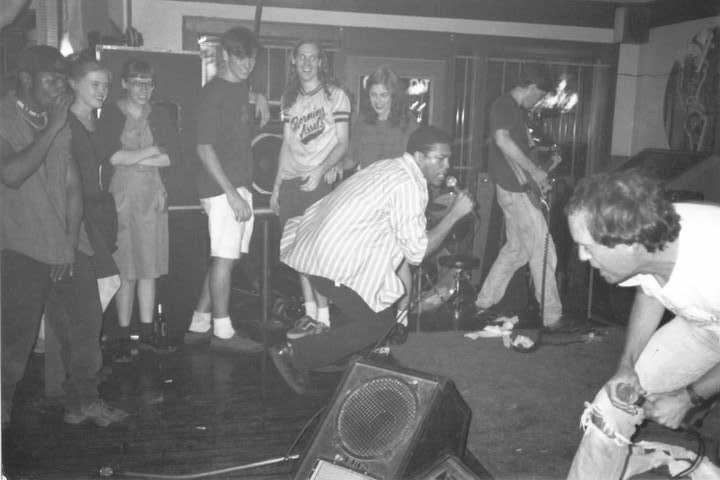Aebmiller
Shared posts
Happily Married Couples Gain More Weight
Photoshop in Real Life: Portrait Series Takes Tools Literally
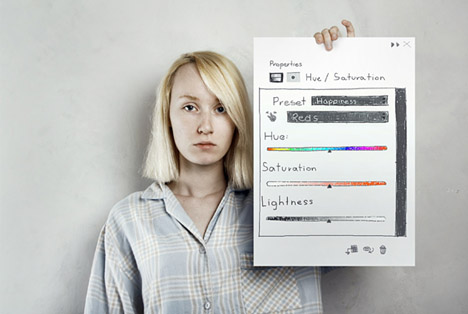
Anyone who has used Adobe products, Photoshop or otherwise, knows that they have necessarily become quite creative in naming some of their more abstract, surreal and unusual functions.
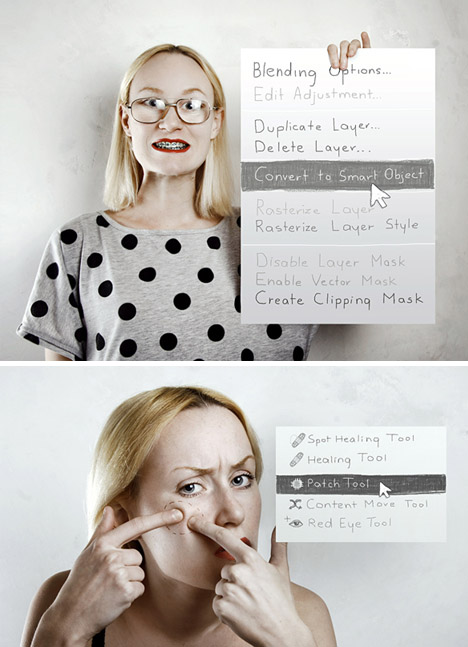
Flora Borsi of Budapest, Hungary, is a photographer and photo editor who has explored these meanings in return, taking them back out of the digital realm and applying them to ‘real life’ situations.
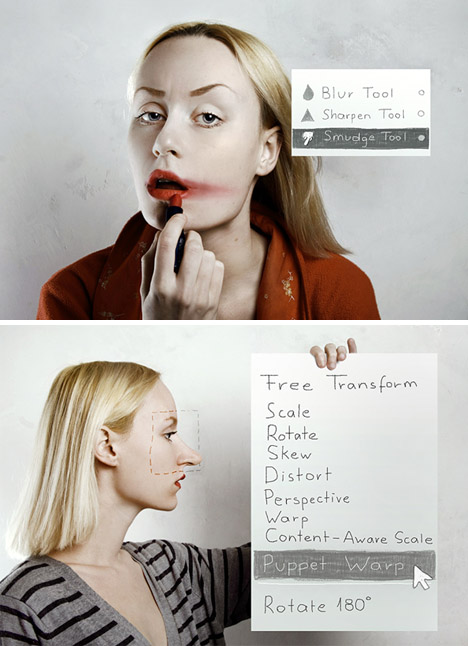
Through turns of phrase (‘Convert to Smart Object’) and other twisted interpretations, this series of portraits is an exploration of self, exhibition of abilities and simply fun series of mildly manipulated photos.

Her other series show off her capacity to understand and reproduce historical styles, but also to take and subvert visual expectations, in turn silly, serious and in some cases quite macabre.




[ By WebUrbanist in Design & Graphics & Branding. ]
[ WebUrbanist | Archives | Galleries | Privacy | TOS ]
    
|
Frightening Archaeological Finds: 15 Odd Human Remains
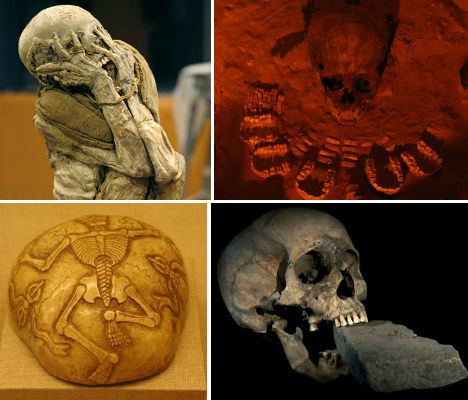
What bizarre and terrifying ‘treasures’ from long-gone ancient civilizations are still hidden in crypts, caves and deep within the earth? Most archaeologists may spend their days painstakingly brushing sand off pieces of pottery, but occasionally, they unearth evidence of the darker side of humanity – cannibalism, sacrifice, mass murder, deadly paranoia about vampires and witches, and even chemical warfare. These 15 archaeological finds of ancient human remains are among the most grisly, frightening and fascinating.
Vampire of Venice
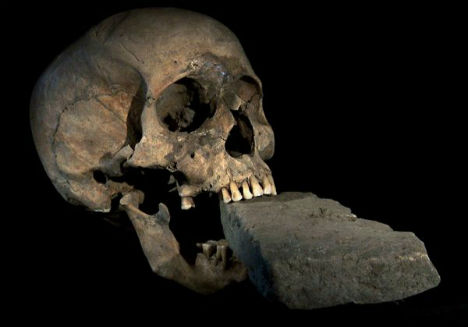
Among the corpses of medieval plague victims was one very curious find: a skull with a brick shoved so forcefully between its jaws, they were broken. The technique was used on suspected vampires in Europe during this time, especially when natural biological processes after death resulted in dark blood-like liquid streaming from the mouth. Researchers have determined that not only was this elderly woman feared a vampire after her death, she may have been accused of witchcraft before she met her end. Most people didn’t live to be her age, estimated at 60-71 years, and many medieval Europeans believed that the devil gave the elderly powers to cheat death. Older women were particularly suspect because it was assumed that they had little to live for, and were vulnerable to offers of power.
The Screaming Mummies


Imagine opening a sarcophagus to find a mummy that seems to be screaming for all eternity. In the past, when ‘screaming mummies‘ were discovered, archaeologists assumed that they must have been buried alive or killed in some other painful manner. Now, however, they usually agree that mummies are commonly found with their jaws open due to their heads falling back after death. The most famous screaming mummy is Unknown Man E, an Egyptian mummy found in 1886, who could be the murderous son of Ramses III. Another is even more shocking, with its hands covering its face in apparent terror; it was among the remains of the Chachapoya Indians of Peru.
Pile of Headless Vikings

Evidence of a shocking massacre was discovered when archaeologists unearthed 51 thousand-year-old skulls – along with another pit containing their headless bodies – in Weymouth, UK. Found in 2009, these young male Vikings were brutally slain sometime between 910 and 1030 CE. Analysis of their teeth confirmed that they were from Scandinavia. They were likely war captives of the Anglo-Saxons, executed by having their heads hacked off.
Neanderthal Cannibals

The bones of twelve neanderthals found in a cave in Spain were cut and snapped, indicating that they were likely ‘processed’ by fellow neanderthals as food. The possible family group, which included three adult males, three adult females, three adolescents, two children and an infant, is one of the most significant examples of cannibalism among neanderthals. “There are many different markings in many different bones in all 12 individuals, including traditional cut marks to disarticulate bones and remove muscle insertions, snapping and fracturing of long bones to extract the marrow,”researcher Carles Lalueza-Fox told LiveScience.
Bathhouse Baby Disposal

How and why were the bones of nearly 100 infants discarded like trash in a late Roman, early Byzantine sewer beneath a bathhouse in Israel? Found in 1988 in Ashkelon, the remains indicate that the babies died before three days of age, and show no signs of disease or skeletal malformation. While scholars hypothesized that the babies were girls, since female infanticide was common during that time, tests have since shown that many were male. The reasoning behind their death is still a mystery.
The First Leper

The earliest archaeological evidence of leprosy is found in a 4,000-year-old skeleton unearthed in India in 2009. Leprosy is difficult to study because the bacteria that causes it is tricky to culture for research, and scientists are still unsure of exactly when and where it originated. This skeleton was not only the oldest leper ever found, it was also the first evidence of leprosy in ancient India, supporting the idea that the disease migrated between Africa and Asia during a period of urbanization, growing population density and new trade routes.
Murdered Bog Bodies
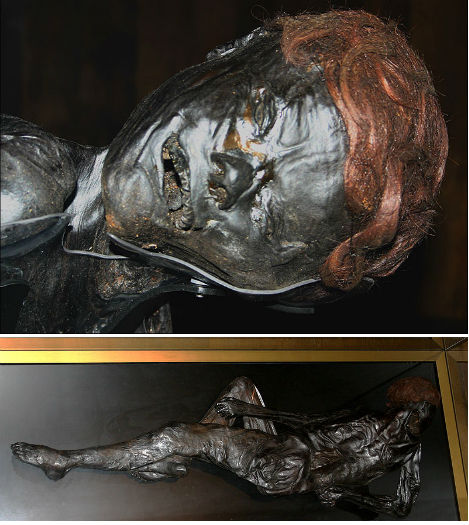
The peat bogs of northwestern Europe have turned out to be one of the richest sources of ancient human remains in the world, preserving bodies so perfectly that they sometimes still contain blood and stomach contents. ‘Bog bodies‘ such as the Grauballe Man, pictured, date from 8,000 B.C.E. to the early medieval period. It seems that these people were not buried in the peat bogs, nor did they simply die there – they died violently. Researchers believe they were most likely sacrificed, or executed as punishment for crimes or perceived flaws.
Skulls Used as Cups
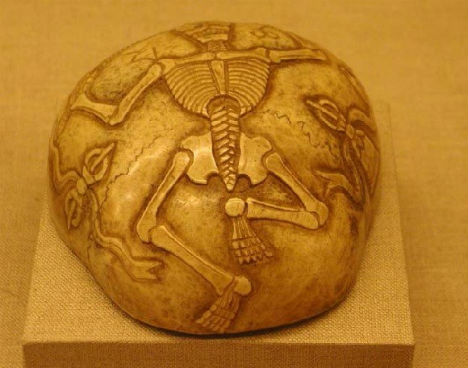
Three human skulls found in Gough’s Cave, Somerset, England were carefully worked into the shape of bowls, indicating that they were used to drink from. At 14,700 years old, these are the oldest skull cups ever discovered, and they were surrounded by other human remains that had been snapped to get to the marrow inside, suggesting cannibalism.
Next Page:
Frightening Archaeological Finds 15 Odd Human Remains




[ By Steph in Culture & Cuisine & Global. ]
[ WebUrbanist | Archives | Galleries | Privacy | TOS ]
 |
 |
NIH Study Sheds Light On How To Reset The Addicted Brain
Bizarre Dying Wishes Of The Day
Aebmillerread the first one, leah
Knitted Portraits of Dr. Who Actors
The Origin of “Say Cheese” and When People Started Smiling in Photographs
 “Say cheese!” This simple command is meant to elicit a smile from potential photography subjects no matter what their age. It has become so commonplace that the word “say” is often no longer uttered. A simple “cheese” spreads a smile across anyone’s face, and with a click of a button, that smile is captured for eternity.
“Say cheese!” This simple command is meant to elicit a smile from potential photography subjects no matter what their age. It has become so commonplace that the word “say” is often no longer uttered. A simple “cheese” spreads a smile across anyone’s face, and with a click of a button, that smile is captured for eternity.
No one can say for sure who coined the phrase “say cheese” for use in getting people to smile, nor can we say with 100% certainty why that particular phrase was chosen as the smile spreader. The leading theory, however, as to the “why” of “say cheese” is that the “ch” sound causes one to position the teeth just so, and the long “ee” sound parts their lips, forming something close to a smile.
The phrase appears to have been first used in this way around the 1940s, with one of the earliest references appearing in The Big Spring Herald in 1943:
Now here’s something worth knowing. It’s a formula for smiling when you have your picture taken. It comes from former Ambassador Joseph E. Davies and is guaranteed to make you look pleasant no matter what you’re thinking. Mr. Davies disclosed the formula while having his own picture taken on the set of his “Mission to Moscow.” It’s simple. Just say “Cheese,” It’s an automatic smile. “I learned that from a politician,” Mr. Davies chuckled. “An astute politician, a very great politician. But, of course, I cannot tell you who he was…”
It is thought the “politician” he was referring to was none other than Franklin D. Roosevelt, who Ambassador Davies served under. So did President Roosevelt himself come up with the phrase or simply learn it from someone else? Nobody knows, but soon after, saying cheese became a common phrase for people to utter when trying to get people to smile in photographs.
You wouldn’t have had to worry so much about this cheesiness in the Victorian era (1837-1901). During this period, etiquette and beauty standards were much different than they are today. In Victorian times, a small, tightly controlled mouth was considered beautiful. In fact, photographers during this era elicited the desired portrait expression by having their subjects “say prunes”. Smiles during this time were only typically captured on children, peasants, and drunks.
One of the most common culprits blamed for the neutral expressions on subjects during the Victorian era is the long exposure time for photographs to be taken. To understand where this reasoning comes from and why it is likely incorrect, you need a very brief history of photography.
The creation of permanent images began with Thomas Wedgewood in 1790, but the earliest known camera image belongs to French inventor Joseph Nicephore Niepce in 1826. The photograph is entitled, “View From the Window at Le Gras”. It is historically said to have required 8 hours of exposure time, but in reality it could have taken as long as a few days.
An exposure time of this length was obviously not conducive to capturing images of people and so the quest to do so continued. In 1839, Louis Daguerre introduced a new form of photography, Daguerrotype, where a positive of the image was developed directly on the photographic plate. This did not allow for reproduction of shots taken, but it did cut down exposure time significantly. Daguerrotypes remained extremely popular until the 1860s. From 1839 – 1845, exposure time for Daguerrotypes was about 60 – 90 seconds, which was a long time to remain motionless and hold a smile, but not impossible.
By 1845, exposure time on daguerrotypes was cut to only a few seconds. The majority of pictures we see are daguerrotypes taken after 1845, thus eliminating the blame for the lack of pearly whites shown by our ancestors of the Victorian era on long exposure time.
Speaking of pearly whites- the next most common reason cited for people not smiling in photographs in the Victorian era is blamed on dental hygiene. The most common cure for sick teeth during this time was to pull them out. There were no caps or other fixes to make chipped or broken teeth more aesthetically pleasing. So perhaps the reason tightly controlled mouths were considered more beautiful than beaming smiles in the Victorian era was in part due to dental hygiene.
Keep in mind too that daguerrotypes were expensive. The rich were more likely to be photographed than the poor, and even then, most families were only photographed on special occasions, perhaps only even once in a lifetime. The majority of these photographs were taken in a professional photography studio. There was nothing casual about photos taken then and the etiquette for formal occasions at that time was to act “prim and proper”. What was socially acceptable in photography during the Victorian era mirrored the beauty and etiquette standards of the times. You wouldn’t want to pay all that money and have the one time you’re photographed in your lifetime showing you smiling like a drunkard!
Fast forward to 1888. This is the year George Eastman founded Kodak, a company most widely known for its production of photographic films. Kodak changed the face of photography in more ways than one. Kodak brought photography to the masses and to all occasions ranging from super casual to superbly formal. The company introduced its first pocket camera at a cost of $5 ($135 today), the Pocket Kodak, in 1895. It was the introduction of Kodak’s $1 Brownie camera in 1900, however, that changed the world of photography forever.
The Brownie camera was intended to be so inexpensive and so simple to use that anyone could take a picture. In fact, the Kodak slogan at this time was, “You push the button, we do the rest.” Photography as a hobby was now a possibility. Capturing “everyday” moments was now a reality- more and more smiles were now captured on film.
With the invention of film also came the movie industry. Although the majority of films made before 1930s were silent, everyday moments and facial expressions were reproduced on the big screen for all to see. Movie stars of that era were captured in photographs with *gasp* smiles. As we know, the media and Hollywood have a huge influence on social etiquette and beauty standards. As more and more celebrities were captured on film smiling, the smile became more socially accepted as beautiful and as an acceptable thing to do in photographs.
So when did it become tradition for people to smile in photographs? This happened in the beginning of the 1900s, due to more and more casual moments being caught on film both in Hollywood and amongst family and friends.
If you liked this article, you might also like:
- A Dog’s Mouth is Not Cleaner Than a Human’s Mouth
- Why Garlic Makes Your Breath Smell Bad
- Why Wintergreen Lifesavers Spark When Chewed
- The History of Dentistry
- Baking Soda Makes a Good Cheap Teeth Whitener
Bonus Facts:
- George Washington is one of those who had incredibly bad teeth and by his inauguration in 1789, he had only one natural tooth remaining- this would have been hardly a dignified look in his Presidential portrait, had he chosen to smile.
 Despite what you may have heard, though, he did not have wooden dentures.
Despite what you may have heard, though, he did not have wooden dentures.
- Today, one of the more well-known and inexplicably popular photographic “smiles” for teenagers and some young adults is the “duckface”. This is usually performed by females during self-photographs with said photography subjects pressing their lips together in a half pout, half kiss formation, causing them to look very similar to a duck’s bill. This may be yet again owing to the influence of Hollywood, with the obsession with botoxed, full-looking lips. Who knew Daisy Duck would become the new face of “beauty”?
[Smiling Girls Image via Shutterstock]
Expand for References
First Strong Evidence Of Bi-Directional Relationship Between Music And Language
Hallucinations of Musical Notation
Source: ScienceDaily
A physician and neurologist has outlined case studies of hallucinations of musical notation, and commented on the neural basis of such hallucinations.“A Mere Male”: Mansplaining Women’s Art
Guest Blogger Bio: Leah Zoller is a translator and writer currently working in Japan. She writes about Japan, gender, and media on her blog The Lobster Dance and about food culture (including gender) on her other blog, I’ll Make It Myself!
This post originally appeared on The Lobster Dance on 2013/03/14
One of the most striking scenes in the 2012 miniseries version of Ford Maddox Ford’s Parade’s End is one in which suffragette Valentine Wannop takes refuge in an art museum during a rally. While she is quietly admiring a painting of Venus, another woman enters and slashes the painting with a cleaver, shouting, “What are you all gawking at? Do you think that is all women are good for?”1
As someone with a deep love of art, I was alarmed as Valentine was. I do not believe in the destruction of art, but what the stand-in for Mary Richardson said stuck with me. Consider the status of women in the art world: often considered the “muse,” rarely the artist; lauded as the pinnacle of beauty but having no worth otherwise: the Venus forever looking in her mirror, the object of the (male) gaze, not the subject of her own agency. Should a gallery or museum try to strive for the inclusion of women artists (and artists of color, queer artists, and so on), there may be criticism of ignoring the masters, so-called “female privilege,” and the desire for a gender-blind meritocracy that simply does not exist at present. If you were wondering what such an article might look like, look no further than C.B. Liddell’s “The diverse works of Asian women artists,” a special to The Japan Times.
Liddell begins,
I don’t normally visit exhibitions in company, but this time I made an exception and press-ganged a female acquaintance to join me. The reason for this was that the show I visited, “Women In-Between: Asian Women Artists 1984-2012″ at the Tochigi Prefectural Museum of Art, is an exhibition of female artists’ work. As a mere male, I didn’t quite feel equipped enough in my own right to deal with this.
Well, Mr. Liddell, allow me and my ovaries to talk you through this one.2
Introducing identity issues is problematic enough when you do it into the wider society, against a background of, say, social justice or inclusivism; but it is even more of a problem when it is done in an area like art, which should essentially be meritocratic. What we really want when we visit an exhibition is to encounter genius and talent, and that should be regardless of the number of Y-chromosomes involved.
While I agree that art ought to be displayed for its merit, the present state of the world, the art world included, is not a meritocracy, though it may masquerade as one. The art world has the same problems with female and minority under-representation at the top levels as the fields of politics, science, and business. Women are grossly underrepresented in the art world, not in terms of the number of female art students or artists, but in the number of female artists whose work is displayed in museums and in solo and group exhibitions.3
It could be argued that concentrating on women and Asian artists may help create a sense of narrative and meaning. However, the group in question is such a vast and diverse one that it can’t really be summed up in a coherent narrative, even if you refer to some of the feminist shibboleths about the general oppression of women. And whether such gender despotism is a fact or not is beside the point, because nothing stifles art as surely as didacticism and an earnest, heavy-handed message — even if it is justified.
Instead of attempting to guess at the exhibit’s intent, I’ll let the Tochigi Prefectural Museum of Fine Arts speak for itself through the conveniently provided statement on their website (English | 日本語):
Recent years have seen a drastic change in circumstances surrounding Asian women artists. Since the rapid growth of Asian countries, particularly China and India, in economic development and international politics and the rising consciousness of gender issues in Asian society, the waves of time are bringing about unprecedented structural shifts to the relationship between women and society, as well as between Asia and the rest of the world. Under such conditions, what are the concerns, feelings and perspectives of Asian women artists, and how are they trying to express their subject matters? Through works produced from the 1980s to the present, by women artists who were born and based in Asia as well as who live abroad, this exhibition shows women’s various concerns and diversified expressions as well as their changes.
Specifically this exhibition is composed of some 110 works of 48 participating artists based on their experiences of social gender roles and positions as females , their awareness of female issues posed by daily life, or their concerns with history, war, and ethnicity, and of current new trends. Taking a look back over the activities of women artists in the last few decades, the exhibition also looks toward the works of the future. We also hope you will discover the creative and positive possibilities of Asian women artists, which are created by crossing “Asia”, “women” and “art” through the exhibition.
Chapter 1 Women’s Bodies – Sites of Reproduction/Multiplication, Seduction and Violence
Chapter 2-1 Women and Societies: The Roles of Women and Men, and the Bonds Between Women
Chapter 2-2 Women and Societies: The Diaspora and the Marginalized People
Chapter 3 Women and Histories – War, Violence, Death and Memory
Chapter 4 Women’s Techniques and Materials – The Periphery of “Art”
Chapter 5 The Lives of Women – Departing On Her Own-Tochigi Prefectural Museum of Fine Arts, “Women In Between: Asian Women Artists 1984-2012″
In short, the purpose of the exhibition that Liddell criticizes as being incoherent is to show the diversity of Asian women artists. One would hardly argue that the “Asian experience” is universal, so why should “the female experience” be? To return to Liddell’s critique,
So, while the exhibition strives for a meaningful narrative, the diversity of the different artists — and they are very different — luckily defeats this overarching purpose. And this makes for a more confused, but interesting show.
Read: incoherent narratives are fine as long as they don’t highlight gender oppression, the glass ceiling, or the struggle of female artists to be recognized.
The artworks that work best are the ones that resist the grand feminist narrative, either by their subtlety, playful abstruseness or by appealing to aspects of humanity that simply transcend gender.
 “Transcending Gender” means “This is good even though a woman made it.”
“Transcending Gender” means “This is good even though a woman made it.”
Because we wouldn’t want you to feel uncomfortable about not being a woman. Nor would we want to make you consider how each artist’s work is informed by creating a personal identity that may include the refusal or questioning of gendered aspects of her role in her society and the international art scene.
From here, Liddell describes some of the pieces. Although I have not seen the show, the Tochigi Prefectural Museum of Fine Arts has a press release with images of the works and a brief essay , cited above. Of course, one’s taste in art is subjective, and everyone has their own opinions on the merit of individual pieces and artists. Liddell did not care for most of the show, which is his opinion. However, his article is far less of a critique of the art than a piece on how an attempt to balance female representation in the art world makes him uncomfortable.
Interestingly, though, he comments on about Chiharu Shiota’s video piece “Wall,”
[the piece] seems to show her own blood pulsing around her in a spaghetti-like jumble of tubes. Although she is naked in both videos we soon forget she is “a woman” and start to see her instead as a human being.
Women are human, despite the fact that our bodies considered atypical and, as a result, medical research and dissection must be done on men, who have “human” bodies. One rather glaring example of this is the Body Worlds exhibit. Why? Because women’s bodies are sexual objects that lack sufficient structure:
Why are there not more women plastinates in the exhibits?
Sensitive to perceived community concerns, Dr. von Hagens did not want to appear voyeuristic in revealing too many female bodies. Further, he sees himself in the tradition of Renaissance anatomists, whose works traditionally included far more masculine than feminine bodies, since all but the reproductive systems are essentially the same. The musculature of male bodies is generally more pronounced and illustrates more aspects of the muscle system…. (Body Worlds FAQ)
You know, even though we make up half the human population. (There are many, many more examples of this at Sociological Images‘ “Male as Neutral Default.”) But I digress.
As I stated, Liddell’s piece is more focused on the intent of the show than the actual content, and so he quickly delves back into his dislike of the concept of an all-women show:
Another point that might grate after a while is that this feminist critique of society fails to address women’s own collusion in the social order. Women are, after all, a massive part of any society, and some endorse and drive its fashions, lifestyles and moral atmosphere. The feminism here, however, often claims that sexism is the fault of a tiny minority of powerful men, who are by implication pure evil.
Here Liddell accuses women of historically keeping their fellow women down and out, without legal rights and social power, but when women work to get more female representation in an area from which they have been historically excluded, they’re threatening men and men’s rights. And the cherry on top of the irony cake?
But that’s just the viewpoint of a male reviewer, so what did my female companion think? Although deeply interested throughout, her final conclusion was more damning than I expected. According to her, the show lacked what she regarded as that most essential of feminine qualities: emotional warmth.
Does Liddell not realize that he is critiquing women’s supposed collusion in the social order by using a comment from a a woman who is colluding the social order?
Yes, women can be sexist, too. Women who make jokes about how men are “useless” or “dumb” or “incomprehensible” are participating in sexist commentary, but women can have sexism toward their own sex socially ingrained in them. Women (and men) who act as gender enforcers toward other women are also participating in sexist narratives.4
Thus, Liddell’s companion’s appropriation of “emotional warmth” as a feminine attribute is collusion, a propagation of a false gender binary to reinforce his point. Her comment is as damning, to use Liddell’s phrase, in regard to what the inverse implies for someone who only sees “gender” in binary terms: that masculinity is about the lack of emotional warmth. From there, one can extrapolate that men who have emotional warmth are feminine, which is bad because the feminine is lesser, unwanted. By the same “logic,” women who lack emotional warmth should be simultaneously praised for privileging “masculine” means of communication and shunned for denying the “innate nature” of their sex. It does not follow.
Sexism is not, as Liddell seems to suggest, solely about gender oppression from the top or about women raging against “the fault of a tiny minority of powerful men.” While it’s true that a tiny minority of lawmakers (male and female) has deemed my sex unable to retain the right to their own names on the family registry of Japan and that another tiny minority of lawmakers seems to think I don’t have the right to my own body in the US, sexism does, in fact, exist outside the world of institutionalized sexism. In a country where it is easy and legal (vs. the US, which varies by state) for a man to change his name upon marriage, why is the number of men entering their wives’ family registry not about 50%? In a country where everyone was “created equal,” why am I more likely to make 81 cents to a man’s dollar for doing the same work? Furthermore, socialized and institutionalized sexism does not just hurt women; it also hurts men by telling them they aren’t allowed to express emotion, to talk about their problems, to care for their children (parental leave and its stigma), to be vegetarian if they so choose, and to pursue work in “feminine” fields (even though they will likely be paid more). Yes, people can rebel against gender policing, but when one does, as the Tochigi Museum did, they are criticized by the enforcers of the norms.
It is precisely the culture of sexism that exists at the personal, familial, academic, and social level that has led to the need for minority exhibitions like Women In-Between. Until the art displayed in galleries and museums is evenly balanced, art spaces and institutes would do well to address the imbalance in their collections and exhibiting artists, not necessarily by hosting all-women shows, but by giving equal support to display and curate the work of women, to help female art-school graduates find residencies and spaces to create, and to focus on facilitating an art world that does not discriminate based on sex.
As Jerry Saltz wrote regarding MoMA’s lack of women,
Museums are not tombs where people go to simply stare at objects. They are places to participate—places where things you don’t understand change your life. Museums have to not only defend the canon but also delve into and question it. They are guardians of history, but they’re also makers of meaning and metaphors.
The Tochigi Prefectural Museum of Fine Arts is making steps in the right direction. Perhaps the question Liddell ought to be asking is not “why an all-women art exhibition?” but what is it about women’s agency, experience, and inclusion in the art world does he find so alarming?
Notes
1 Though Parade’s End is fictional, this incident actually happened: Mary Richardson took a cleaver to The Toilet of Venus (The “Rokeby Venus”) by Diego Velazquez in the National Gallery of London in protest of the treatment of feminist and suffragette Emmeline Pankhurst.
2 Some women don’t have ovaries, just so we’re clear.
3 See “Are Women Still a Minority in Art Museums?” by the New Britain Museum of Art, which includes a list of resources at the end; Madeleine Zinn’s “More Representation for Women in the Arts!” on Divine Caroline; art critic Jerry Saltz’s “Where Are All the Women?: On MoMA’s identity politics” for New York Magazine and “Where the Girls Aren’t” for The Village Voice; Catherine Coreno’s “Data: Gender Studies: Is MoMA the worst offender? We tallied how women fare in six other art-world institutions” in New York Magazine.
4 “Be a man, don’t cry!”; “Stop dressing like a boy!”; “I can’t believe she’s wearing that; what a slut!”; “Men are bad with children.”; “If you don’t change your name, you don’t love your husband”; “Boys don’t like pink”; “Women are more emotional, so they’re better at creating art”; “Women are more emotional, so they’re bad at politics”; “Are you PMSing?”; “All men are idiots”; “He runs like a girl”; ad nausem, ad infinitum.
Similar Posts:
- Let’s talk about that “ambition gap” by Guest Blogger December 7, 2012
- The Wedding, culture, and my Indian identity by One Brown Woman June 25, 2007
- “Racism Still Exists”: The Power of Art by Guest Blogger January 25, 2013
- Gender Equality in the Arab World by Jill December 12, 2006
- The Myth of Male Decline by Jill October 1, 2012
Ice Hockey Causes 44.3% Of All Traumatic Brain Injuries Among Canadian Kids
Coffee for a Crowd: The Espro Press, A New (& Better) French Press Coffee Maker
An Aeropress has long been the preferred coffee maker in our household, but it's not the best choice for brewing multiple servings. Many a dinner party has ended with one of us stuck in the kitchen, pressing cup after cup for each guest. So we like the idea of having a large Espro press, which is sort of a new-and-improved French press. Not only does it make an excellent cup (or cups!) of coffee, but it looks quite elegant on the table.
 |
 |
Domestic Daredevils: 12 Insanely Cool Home Climbing Walls

When the mountains are too far away and you don’t feel like going to the gym, you can always scale the walls of your living room or bedroom – if you’ve got one of these 12 amazing indoor climbing walls installed in your home. Ranging from the modest and colorfully modern to 36-foot rugged rock walls mimicking natural boulders, these residential climbing walls will give you something to do when you’re tired of watching television.
3 Way House by Naf Architect

A climbing wall offers alternative access to the roof terrace from the first floor, for athletic people who are tired of taking the stairs. Designed by Japanese studio Naf Architect & Design, the 3 Way House in Tokyo turns the climbing wall into a main visual component of the home by placing it in a glassed interior courtyard visible from many rooms.
Modern Indoor Climbing Wall in Tokyo

The ‘Outdoors Indoors’ house by Be-Fun design + EANA in Tokyo features a large indoor climbing wall that hovers over the communal area of the home, ascending into a wood-lined ‘cavern.’
Spiral Slide from Pirate Ship to Climbing Cave
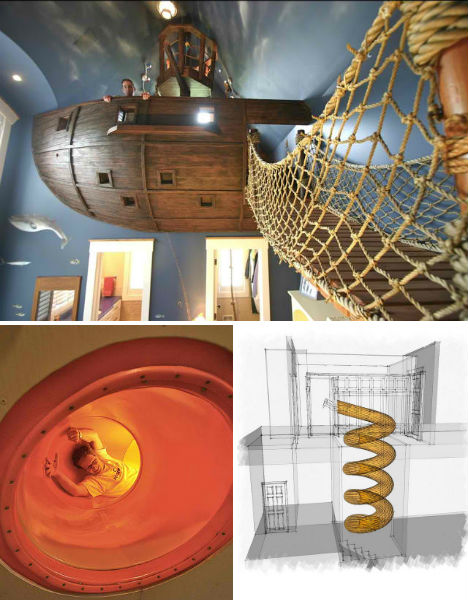

Climb down from an elevated pirate ship replica via drawbridge and head to the mudroom to plunge yourself down a secret spiral slide that will take you all the way down to the ‘climbing cave’ adjacent to a golf simulator room. This house looks insanely fun for kids of all ages.
Yellowstone Club Residence by Krannitz Gehl


Paying tribute both to the rustic traditional cabins of Montana and the state’s rugged beauty, the Yellowstone Club Residence by Krannitz Gehl features a large glass window to maximize views and sun exposure, right next to a large climbing wall. The arrangement almost gives climbers a sense of being outside.
Indoor Treehouse Playroom by Gabriel Builders

Some lucky little kids got an indoor treehouse with their own private miniature climbing wall in this residential project by Gabriel Builders.
House in Izumi-Ohmiya by Tato Architects

A converted warehouse in Osaka by Tato Architects features a double-height living and dining rom with a ladder providing a shortcut to and from the master bedroom. Designed for an active young couple who like ‘bouldering’, a kind of free climbing, the home also features a small climbing wall.
Next Page:
Domestic Daredevils 12 Insanely Cool Home Climbing Walls




[ By Steph in Design & Fixtures & Interiors. ]
[ WebUrbanist | Archives | Galleries | Privacy | TOS ]
 |
 |
Cops Posing as Punks Online, F*** Off!
Hilarious account from Slate this morning about some of the dumbest attempts at enforcement of some of the dumbest laws imaginable: cops pretending to be punks online to ferret out info about illegal unlicensed punk shows in private homes.

Details:
This week the St. Louis band Spelling Bee posted a screencap of emails from an account that they believe was used by the police in a sting before their recent Boston show. It reads like an amazing parody of what you might imagine a cop trying to pose as a young punk would look like.
“Boston Punk Zombie,” reads the crudely-scrawled avatar of a green-mohawked punk with the address bostonbeatgang@gmail.com. That name is apparently a generic-brand knockoff of an infamous Boston hardcore gang. Cred achieved. “What's the point” reads the tagline under the profile pic.
“Too bad you were not here this weekend,” “Joe Sly” wrote. “Patty's day is a mad house I am still pissing green beer. The cops do break balls something wicked here. What's the address for Saturday Night, love DIY concerts.” He might as well have written “Just got an 8 ball of beer and I’m ready to party.”
Is it possible that Joe Sly is a real Boston punk? Sure, though if so he’s the first Boston punk in history to brag about drinking lame St. Patrick’s Day green beer....
The Massachusetts band Do No Harm also tweeted about receiving an email from Joe this month. “whats the 411 for the show saturday?” he asked, apparently using some sort of slang-filter translator from the turn of the century.
Then there’s the case of Donna Giordano, a hip youth who’s recently been reaching out to local show promoters from her Facebook account. “Is the show still going on Friday in JP? If so where. Thnxs,” she wrote in a Facebook message to another local promoter, who also asked to remain anonymous. When he asked her to make him feel comfortable that she wasn't a cop, she replied, “that's a new one. How? Flash a boob Ha Ha Ha how do I know your not some sketchy creep who lures girls to your basement for some Hostel like horror show on the guise of a music show”
Details like that are among the typical warning signs you might find when dealing with an online scam—it’s a recently created account with very few friends, almost no interaction with anyone, and generic-looking pictures. Her cover photos include a snapshot of the No. 66 bus in Allston (so you know she's repping Allston hard), and a generic Boston skyline photo, you know, like most twentysomething girls into the punk scene will always post on their walls. In this light, her “I love the pit!” photo of a mosh pit, obviously taken from an Internet thumbnail, looks like one of the saddest feints ever....
You don’t have to be a local-music Agent Smith, though, to tell that some of these emails smell pretty fishy. “Hey there, local P native here,” wrote one probable imposter to a local band, (who probably meant to type JP, slang for Jamaica Plain). “What is the Address for the local music show tonight?"
The local music show tonight? Who talks like that about a DIY show? Someone not used to talking about music, that’s who....
Boston cops would not admit to the reporter that they are using these techniques. But:
As a result of efforts like this, promoters and houses have become much more cautious when they receive requests out of the blue for information about shows. And this kind of caution may be, in its way, a kind of success for the BPD initiative. It's kind of hard to put on a show when you can't tell anyone ahead of time where it's going to be. In that sense, the cops seem to be succeeding through another tried-and-true Internet tradition. Trolling is almost always transparently obvious, but when it's unflagging and endlessly annoying, it can be extremely discouraging. Troll a group of people hard enough, and they may end up saying, like famed Boston Beat Gang punk Joe Sly, “What's the point?”
Boston punks to cops: We are not amused! The truly punk thing to do, as practiced by old South Florida punk rock band F (and I'm sure dozens of others, they are just the ones I'm acquainted with, having lived with and done business with members of the band) is to call the cops on your own show.
Music Benefits Both Mental And Physical Health
Herbert James Draper

Herbert James Draper was a late Victorian / early 20th century artist who specialized for much of his career in mythological subjects.
His most famous painting, The Lament for Icarus (above, top with detail) is in the Tate (high-resolution version on Google Art Project and Wikimedia Commons).
Earlier in his career he was an illustrator. As the popularity of his mythological and literary subjects, and his classical Victorian approach to painting, waned in his later career, he turned more to portraiture.
[Note: some images on the sites linked could be considered NSFW]
The sleeping child outplays the adult's capacity to convert implicit into explicit knowledge
Aebmillerfreaking children. I think this goes for motor memory too.
Nature Neuroscience 16, 391 (2013). doi:10.1038/nn.3343
Authors: Ines Wilhelm, Michael Rose, Kathrin I Imhof, Björn Rasch, Christian Büchel & Jan Born
When sleep followed implicit training on a motor sequence, children showed greater gains in explicit sequence knowledge after sleep than adults. This greater explicit knowledge in children was linked to their higher sleep slow-wave activity and to stronger hippocampal activation at explicit knowledge retrieval. Our data indicate the superiority of children in extracting invariant features from complex environments, possibly as a result of enhanced reprocessing of hippocampal memory representations during slow-wave sleep.
Firefly Moonshine by Firefly Distillery
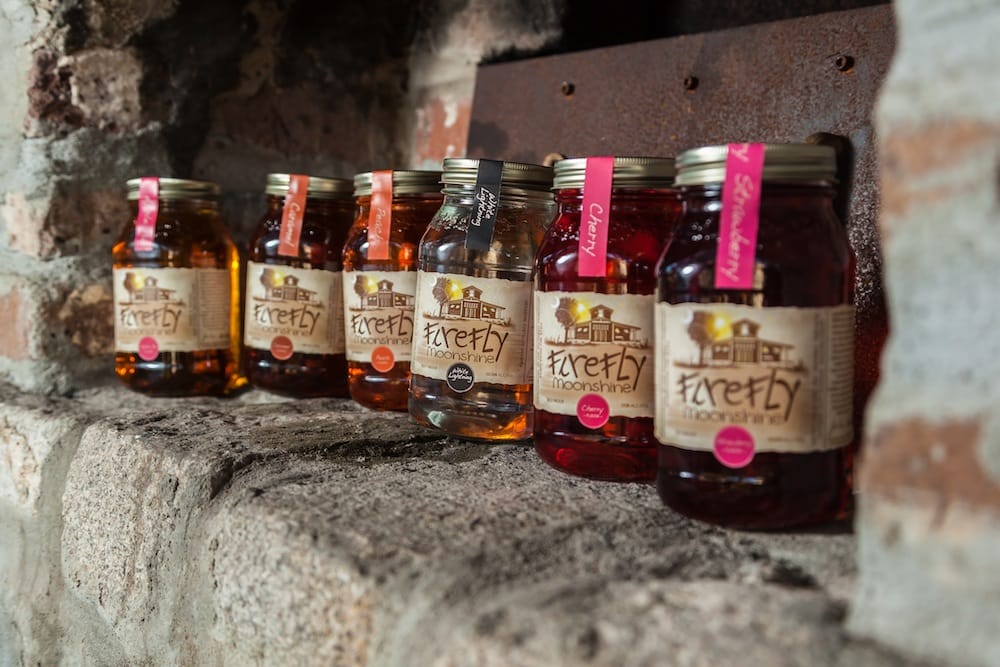
Our Wadlamaw Island friends Firefly Distillery co-founders Jim Irvin and Scott Newitt tell BourbonBlog.com they are the launching of Firefly Moonshine this spring.
The moonshine will be distilled out of South Carolina pride, Firefly Moonshine is a raw southern spirit from the creators of the original Firefly Sweet Tea Vodka.
Firefly Moonshine is produced in six flavors: White Lightning, Apple Pie, Caramel, Cherry, Strawberry, and Peach.
They are between 41.1 and 100.7 proof; 20.55% and 50.35% alcohol by volume. Each has a unique flavor that delivers on low country character yet packs a punch.
While some moonshines on the market have real fruit floating in them, they tell us Firefly Moonshine uses real fruit flavors.
Jim Irvin and Scott Newitt have been experimenting with lots of regional flavors ever since they built their first homemade still.
When Jim and Scott started building the Firefly Distillery, they made a crude still in Jim’s workshop. As Jim explains to BourbonBlog.com, “We started with a 55 gallon stainless steel tank and some old pipes.”
Then we worked on many original recipes until we perfected the very first sweet tea vodka, Firefly. Since that time, we’ve cooked up many fine spirits and some really
good moonshine too!”
“When we first started making the Firefly Moonshine, we kept it to ourselves. It was a ‘distillery secret’ that only a few people knew about. But it tasted
so good our ‘Firefly insiders’ kept asking for it. So we decided it was time to share the good stuff and make it available across the U.S” Scotts explains to BourbonBlog.com.
Firefly Moonshine sales kicked off at
the Distillery Tasting Room in mid-February and it was introduced statewide later in the
month. At this time, it is on its way to licensed liquor distributors, retailers, bars and
restaurants nationwide.
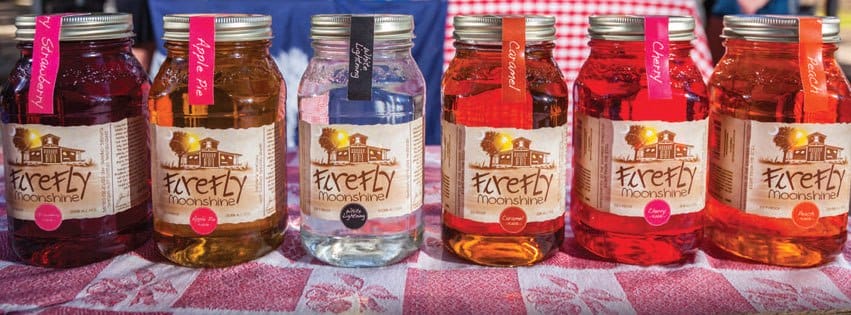
Firefly Moonshine Flavors
Firefly Moonshine is easy to serve & drink.
Enjoy it straight out of the jar, in mixed drinks or make up a big batch of “DIY Firefly Punch.” This recipe makes 55 servings, 6 oz. drinks:
- 1 jar Firefly White Lightning Moonshine
- 2 jars of any flavor of Firefly Moonshine
- 2 gallons of your favorite juice(s)
- Fresh fruit
Instrutions:
Mix in pitcher or tub

Firefly Distillery co-founders, Jim Irvin (L) and Scott Newiit (R) introduce Firefly Moonshine.
Like this article? Here are some other articles of interest:
- Firefly Sweet Tea Bourbon released by Firefly Distillery, South Carolina
- Firefly Distillery’s Cocktails with a Cause
- Firefly Sweet Tea Bourbon Review
- National Iced Tea Day Recipe with Firefly Sweet Tea Vodka
Kentucky Legislature Passes Hemp Bill, Rand Paul Vows Support From D.C.
 The Kentucky Senate joined the House in
approving a hemp regulation bill last night. This morning, Sen.
Rand Paul (R-Ky.) released a statement applauding the bill's
passage and promising to continue to push for a federal waiver from
the Controlled Substances Act for future Kentucky hemp growers:
The Kentucky Senate joined the House in
approving a hemp regulation bill last night. This morning, Sen.
Rand Paul (R-Ky.) released a statement applauding the bill's
passage and promising to continue to push for a federal waiver from
the Controlled Substances Act for future Kentucky hemp growers:
“I commend the Kentucky General Assembly for final passage of Senate Bill 50. I want to thank Kentucky Commissioner of Agriculture James Comer, Senate Agriculture Committee Chairman Paul Hornback and the members of the Kentucky Industrial Hemp Commission for their leadership and hard work in passing this legislation,” Sen. Paul said.
“Senate Bill 50 is an important step forward in the reintroduction of industrial hemp in Kentucky. I have pledged, along with Rep. John Yarmuth, to seek a waiver when a regulatory framework is in place. I will follow through on that pledge and I hope that Kentucky will soon start growing hemp, creating jobs and leading the nation in this industry again.”
Earlier this month, libertarian activist Matt Hurtt wrote for Reason about Kentucky's push for industrial hemp legalization, and the support role Paul and Sen. Mitch McConnell are playing at the federal level.
Eno
Aebmillerlove him
TV Viewing Linked to Antisocial Behaviors in 5-Year Olds
Source: Google News - Health
Five year-olds who watch TV for 3 or more hours a day have an increasingly higher risk of developing antisocial behaviors, such as stealing or fighting, by the age of 7. However, the likelihood of this behavior is very small, according to the experts, who also ...The Dwarves of Auschwitz: A Truly Remarkable Story
Source: The Guardian
The story of a family of dwarves snatched from the gas chamber by Josef Mengele himself sounded incredible. But how to verify the testimony of Holocaust survivors? And should you even try? 'I was saved by the grace of the devil," Holocaust survivor Perla Ovitz told us. Again and again, she recounted in detail how she and her family were taken to the gas chamber and ordered to strip naked. A heavy door opened and they were pushed inside. "It was...Body Paint Illusions Transform Human Models into Animals
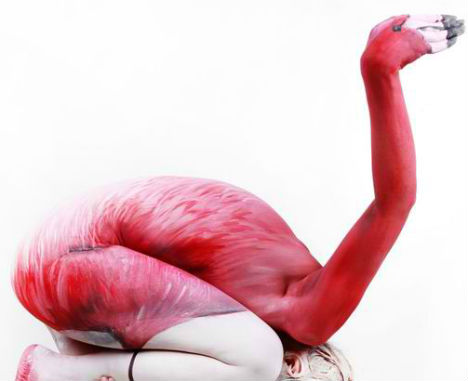
Intricately painted and carefully posed, the human bodies serving as canvases for artist Gesine Marwedel are virtually unrecognizable as they morph into swans, flamingos and iguanas. The 25-year-old German painter employs performance artists to bring her colorful illusions to life, leaving their faces and other body parts visible as part of each composition.
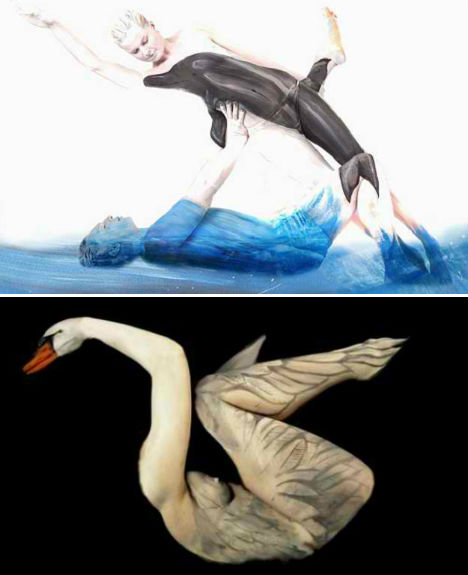
The ability to contort into unusual positions is a crucial element of making each of these incredible three-dimensional paintings work. Each photograph depicts not only the painted animal, but also its grace and movement.
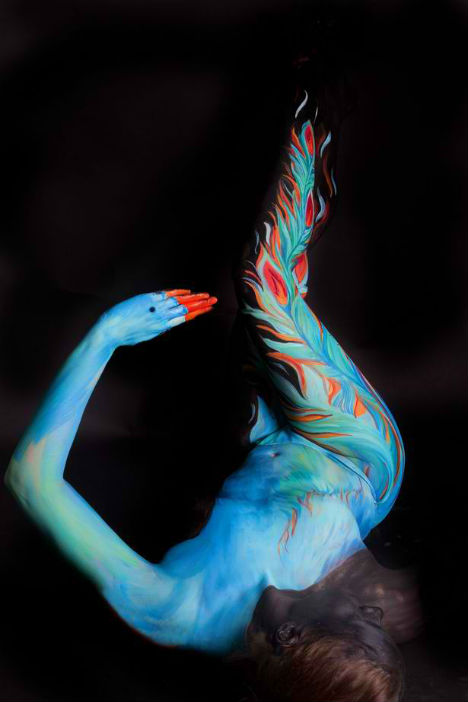
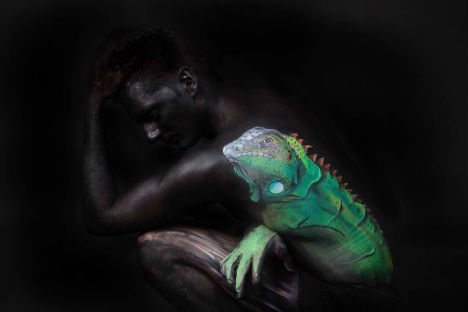
“Body painting is not just paint on a living canvas, it is picking up the body shapes in a subject and the painting on the body,” Marwedel told PSFK. “It is the transformation of a human being into a breathing, moving, living work of art.”
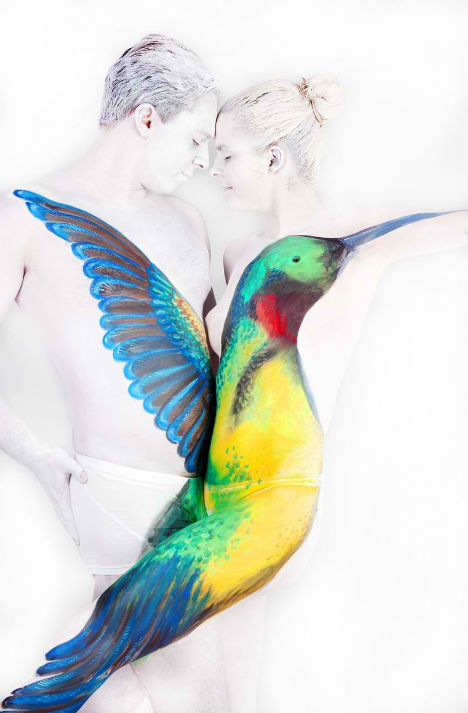
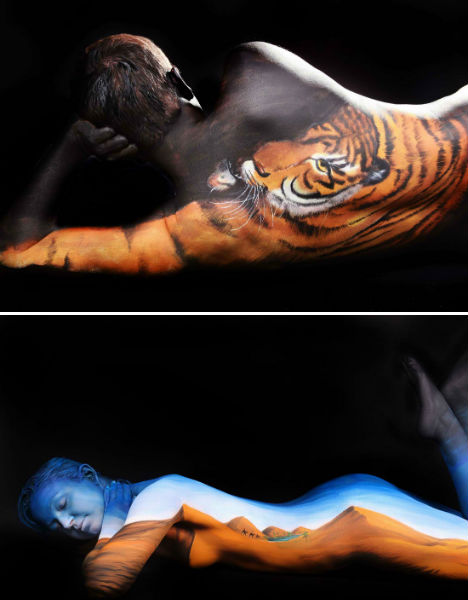
Marwedel began to explore body art after providing therapy for disabled and autistic children through speech and music. See more of her work at her website, or in person at the World Body Painting Festival, to be held in Austria in July 2013.




[ By Steph in Art & Drawing & Digital. ]
[ WebUrbanist | Archives | Galleries | Privacy | TOS ]
 |
 |
A declaration of independence
Writes Kate in Georgia: “My niece, Emily, has to be the most adorable revolutionary in existence. Last week she self-published her manifesto. There are actually six pages of demands, each printed on butterfly stationery. (We assume the butterfly symbolizes her freedom from authority.)”
related: See you never again in my life!
Should Science on Brain Injury Inspire a Ban on Boxing?
Source: Yahoo News - Science
When Ireland's Katie Taylor was taking hits and striking blows for boxing's Olympic debut in an east London ring last year, John Hardy did not want to look. To this leading neuroscientist and molecular biologist, a boxing bout is little more than a session of mutual brain injury. He was horrified to see women boxing at Olympic level for the first time at the London 2012 Games. ...Pneumonia Patients Nearly Twice As Likely to Suffer from Depression
AebmillerI guess it's good I wasn't hospitalized
Source: ScienceDaily
Long-term cognitive and functional impairments that follow pneumonia hospitalization are comparable to the negative health effects of heart disease.





